[English] 日本語
 Yorodumi
Yorodumi- PDB-2mwg: Full-Length Solution Structure Of YtvA, a LOV-Photoreceptor Prote... -
+ Open data
Open data
- Basic information
Basic information
| Entry | Database: PDB / ID: 2mwg | ||||||
|---|---|---|---|---|---|---|---|
| Title | Full-Length Solution Structure Of YtvA, a LOV-Photoreceptor Protein and Regulator of Bacterial Stress Response | ||||||
 Components Components | Blue-light photoreceptor | ||||||
 Keywords Keywords | PROTEIN BINDING / Photoreceptor / LOV/PAS / Stressosome / Rsb | ||||||
| Function / homology |  Function and homology information Function and homology information | ||||||
| Biological species |  | ||||||
| Method | SOLUTION NMR / monte-carlo simulated annealing using torsion angle dynamics, simulated annealing. | ||||||
 Authors Authors | Jurk, M. / Bardiaux, B. / Schmieder, P. | ||||||
 Citation Citation |  Journal: To be Published Journal: To be PublishedTitle: Solution Structure of YtvA from Bacillus subtilis Provides Insight into Activation Mechanism and Regulation of Bacterial Stress Response. Authors: Jurk, M. / Dorn, M. / Reichenwallner, J. / Bardiaux, B. / Hinderberger, D. / Schmieder, P. | ||||||
| History |
|
- Structure visualization
Structure visualization
| Structure viewer | Molecule:  Molmil Molmil Jmol/JSmol Jmol/JSmol |
|---|
- Downloads & links
Downloads & links
- Download
Download
| PDBx/mmCIF format |  2mwg.cif.gz 2mwg.cif.gz | 1.6 MB | Display |  PDBx/mmCIF format PDBx/mmCIF format |
|---|---|---|---|---|
| PDB format |  pdb2mwg.ent.gz pdb2mwg.ent.gz | 1.4 MB | Display |  PDB format PDB format |
| PDBx/mmJSON format |  2mwg.json.gz 2mwg.json.gz | Tree view |  PDBx/mmJSON format PDBx/mmJSON format | |
| Others |  Other downloads Other downloads |
-Validation report
| Summary document |  2mwg_validation.pdf.gz 2mwg_validation.pdf.gz | 687.7 KB | Display |  wwPDB validaton report wwPDB validaton report |
|---|---|---|---|---|
| Full document |  2mwg_full_validation.pdf.gz 2mwg_full_validation.pdf.gz | 1.1 MB | Display | |
| Data in XML |  2mwg_validation.xml.gz 2mwg_validation.xml.gz | 189.3 KB | Display | |
| Data in CIF |  2mwg_validation.cif.gz 2mwg_validation.cif.gz | 202.2 KB | Display | |
| Arichive directory |  https://data.pdbj.org/pub/pdb/validation_reports/mw/2mwg https://data.pdbj.org/pub/pdb/validation_reports/mw/2mwg ftp://data.pdbj.org/pub/pdb/validation_reports/mw/2mwg ftp://data.pdbj.org/pub/pdb/validation_reports/mw/2mwg | HTTPS FTP |
-Related structure data
| Similar structure data | |
|---|---|
| Other databases |
|
- Links
Links
- Assembly
Assembly
| Deposited unit | 
| |||||||||
|---|---|---|---|---|---|---|---|---|---|---|
| 1 |
| |||||||||
| NMR ensembles |
|
- Components
Components
| #1: Protein | Mass: 29148.361 Da / Num. of mol.: 2 / Fragment: UNP residues 2-261 Source method: isolated from a genetically manipulated source Source: (gene. exp.)   #2: Chemical | |
|---|
-Experimental details
-Experiment
| Experiment | Method: SOLUTION NMR | ||||||||||||||||||||
|---|---|---|---|---|---|---|---|---|---|---|---|---|---|---|---|---|---|---|---|---|---|
| NMR experiment |
|
- Sample preparation
Sample preparation
| Details |
| ||||||||||||||||||||||||||||||||||||||||||||||||||||||||||||||||||||||||||||||||||||||||||||||||
|---|---|---|---|---|---|---|---|---|---|---|---|---|---|---|---|---|---|---|---|---|---|---|---|---|---|---|---|---|---|---|---|---|---|---|---|---|---|---|---|---|---|---|---|---|---|---|---|---|---|---|---|---|---|---|---|---|---|---|---|---|---|---|---|---|---|---|---|---|---|---|---|---|---|---|---|---|---|---|---|---|---|---|---|---|---|---|---|---|---|---|---|---|---|---|---|---|---|
| Sample |
| ||||||||||||||||||||||||||||||||||||||||||||||||||||||||||||||||||||||||||||||||||||||||||||||||
| Sample conditions | Ionic strength: 70 / pH: 6.5 / Pressure: ambient / Temperature: 300 K |
-NMR measurement
| NMR spectrometer | Type: Bruker Avance / Manufacturer: Bruker / Model: AVANCE / Field strength: 600 MHz |
|---|
- Processing
Processing
| NMR software |
| ||||||||||||||||||||||||||||||||||||||||
|---|---|---|---|---|---|---|---|---|---|---|---|---|---|---|---|---|---|---|---|---|---|---|---|---|---|---|---|---|---|---|---|---|---|---|---|---|---|---|---|---|---|
| Refinement | Method: monte-carlo simulated annealing using torsion angle dynamics, simulated annealing. Software ordinal: 1 Details: OWING TO THE RELATIVELY LOW NUMBER OF RESTRAINTS TO DETERMINE THE STRUCTURE AB INITIO, STRUCTURES OF THE FOUR MAJOR SEGMENTS WERE CALCULATED USING CS-ROSETTA. 12,000 AND 2,000 STRUCTURES ...Details: OWING TO THE RELATIVELY LOW NUMBER OF RESTRAINTS TO DETERMINE THE STRUCTURE AB INITIO, STRUCTURES OF THE FOUR MAJOR SEGMENTS WERE CALCULATED USING CS-ROSETTA. 12,000 AND 2,000 STRUCTURES WERE CALCULATED FOR LOV OR STAS AND NCAP OR JA, RESPECTIVELY. THE LOWEST ENERGY STRUCTURE WAS FURTHER USED. THE STRUCTURES OF THE FOUR SEGMENTS OBTAINED BY CS-ROSETTA WERE REFINED AGAINST THE RDCS USING LOW TEMPERATURE SA. 100 STRUCTURES WERE CALCULATED AND THE CLOSEST TO AN AVERAGE OF THE 10 LOWEST ENERGY STRUCTURES WAS USED IN THE NEXT STEP. ALL FOUR SEGMENTS (NCAP, LOV, JA, STAS) WERE COMBINED TO A DIMERIC FULL-LENGTH STRUCTURE. THE YF1 STRUCTURE (PDB 4GCZ) WAS USED AS A TEMPLATE FOR THE ALIGNMENT OF LOV AND NCAP IN THE DIMER. ALL FOUR SEGMENTS WERE TREATED AS RIGID BODIES IN A HIGH TEMPERATURE SIMULATED ANNEALING. 100 STRUCTURES WERE CALCULATED AND THE CLOSEST TO AN AVERAGE OF THE LOWEST 10 WAS USED IN THE LAST REFINEMENT STEP. THE FINAL STRUCTURAL ENSEMBLE WAS OBTAINED USING THE SAME REFINEMENT PROTOCOLS AS IN STEP 2. 100 STRUCTURES WERE CALCULATED AND THE LOWEST 10 ARE SUBMITTED. | ||||||||||||||||||||||||||||||||||||||||
| NMR constraints | NOE constraints total: 1192 / NOE intraresidue total count: 58 / NOE long range total count: 294 / NOE medium range total count: 380 / NOE sequential total count: 452 / Protein chi angle constraints total count: 0 / Protein other angle constraints total count: 0 / Protein phi angle constraints total count: 412 / Protein psi angle constraints total count: 402 | ||||||||||||||||||||||||||||||||||||||||
| NMR representative | Selection criteria: closest to the average | ||||||||||||||||||||||||||||||||||||||||
| NMR ensemble | Conformer selection criteria: structures with the lowest energy Conformers calculated total number: 100 / Conformers submitted total number: 10 |
 Movie
Movie Controller
Controller



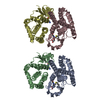
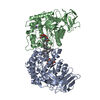
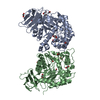
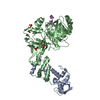
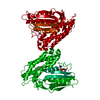


 PDBj
PDBj



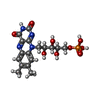

 X-PLOR NIH
X-PLOR NIH